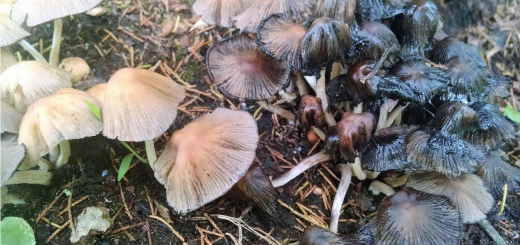#105: Pseudohydnum gelatinosum, The Toothed Jelly Fungus
This is one of the strangest fungi you can find in North America. Like other jelly fungi, it is characterized by its squishy, gelatinous texture. Most jelly fungi have a fairly disorganized, globular structure. However, Pseudohydnum gelatinosum has a distinct stipe, pileus, and spore surface. In fact, its spores are borne on teeth, much like the unrelated Hedgehog Mushroom (Hydnum repandum)!
H. gelatinosum is a relatively small mushroom; it grows up to 7cm (~3in) across and 6cm (~2.5in) tall. It has an extremely unusual shape for a jelly fungus: a tongue-shaped to kidney-shaped pileus with a stipe connecting at the edge of the pileus. The upper surface of the mushroom is flattish with an inrolled margin when young, smooth to slightly fuzzy, and dark brown to pale gray. Although the mushroom’s texture is gelatinous, its surfaces are not slimy. Underneath the pileus, the surface features tiny, conical, tooth-like or spine-like projections that are up to 3mm long. The spines run down the stipe, gradually getting smaller and blending in with the smooth(ish) pileus and stipe base. The spines are colored the same as the flesh, which is translucent, whitish to greyish, and sometimes has a bluish tint. P. gelatinosum’s stipe is very short to well-developed, smooth, and the same color as the pileus or paler. The length of the stipe is related to the orientation of the mushroom on its substrate: a mushroom atop a log or growing on the ground will form a long stipe, but a mushroom growing on the side of its substrate will form a short stipe. P. gelatinosum has no look-alikes in North America. Its squishy texture and well-formed teeth easily separate it from all other mushrooms.
Depending upon its location in North America, P. gelatinosum tends to take on a couple, slightly different morphologies. In Western North America, the mushrooms often fruit terrestrially and feature long, well-developed stipes. On the eastern half of the continent, however, the mushrooms have a tendency to fruit from the sides of logs and form short stipes. Additionally, the eastern form usually has a darker pileus than its western counterpart. There is much overlap between these two morphologies, so the mushrooms remain classified as one species – for now anyway.
The Toothed Jelly Fungus can be found growing from conifer logs and standing, dead conifer trees. The fungus decomposes dead wood and may be mildly parasitic on living trees. Multiple, individual fruiting bodies often form all over the infected wood. The mushrooms appear from late summer through fall, but along the West Coast of North America and in similarly warm climates, they fruit from late fall through mid-winter. They can be found all across North America, but they seem to be patchy and cannot be found in many areas. The Toothed Jelly Fungus is also found in Europe, where it fruits under similar conditions. P. gelatinosum is placed in the phylum Basidiomycota, class Agaricomycetes, and order Auriculariales. The genus is not currently placed in a family. All of P. gelatinosum’s close relatives are jelly fungi, indicating that this mushroom evolved teeth independently of the other toothed fungi.
Most people consider P. gelatinosum an inedible but nonpoisonous mushroom. There is some disagreement, however. Many North American authors (including over half of the sites linked below) consider this mushroom edible—even without being cooked—but agree that it is not a very desirable edible. The mushrooms are bland, small, and rare. You usually do not find enough to make a meal, so the mushrooms are usually overlooked by mycophagists. However, I recently found enough Toothed Jelly Mushrooms fruiting from one log to make a good meal. Unfortunately, this was in a National Park and I had to let them be. If you do want to try eating P. gelatinosum, I would suggest cooking them as you would other edible jelly fungi. Jelly fungi tend to be used in soups and stews to add an interesting texture to the dish.
P.S. Happy two-year anniversary, Fungus Fact Friday!
See Further:
http://www.mushroomexpert.com/pseudohydnum_gelatinosum.html
http://www.mykoweb.com/CAF/species/Pseudohydnum_gelatinosum.html
https://www.messiah.edu/oakes/fungi_on_wood/teeth%20and%20spine/species%20pages/Pseudohydnum%20gelatinosum.htm
http://www.first-nature.com/fungi/pseudohydnum-gelatinosum.php
http://ncrfungi.uark.edu/species/91_pseudohydnumGelatinosum/pseudohydnumGelatinosum.html









![#011: Characteristics of Kingdom Fungi [Archived]](https://www.fungusfactfriday.com/wp-content/themes/hueman/assets/front/img/thumb-small-empty.png)
